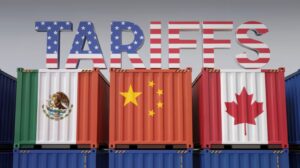5 Ways Insurance Companies Can Stay Financially Ready Through Tariff Changes
The wave of tariff changes is sweeping across the insurance industry, particularly in the home and auto sectors, as claims are ballooning due to rising prices for aftermarket auto parts and construction materials.
Recent estimates suggest these tariffs could add, on average,$324 to car insurance costs and $106 to annual insurance costs by the end of the year.
For insurers, these pressures aren’t just about absorbing costs—they’re about adapting their financial systems to weather a volatile economic landscape.
Navigating Through Tariff Changes
1. Implement Flexible COA
Tariffs introduce unpredictable fluctuations in material and claims costs, making granular financial tracking essential. Having this agility supports smarter pricing strategies and better underwriting insights.
How it benefits insurers:
- Segment reporting by line of business, state, accident year, reinsurance treaty, and more
- Create targeted reports that reveal how tariffs impact specific segments
- Improve cost allocation accuracy for both internal teams and regulators
2. Tighten Compliance to Meet Regulations
Tariff-driven cost increases often trigger regulatory scrutiny. Modern compliance tools built into accounting systems help detect anomalies early and automate much of the reporting process, reducing the burden on internal teams.
How it benefits insurers:
- Timely and accurate financial reporting to state departments and the NAIC
- Consistent adherence to statutory accounting principles (SAP)
- Proper documentation of cost escalations linked to tariff impacts
3. Modernize Accounting Software
Modern software empowers finance teams to act quickly and confidently, even in uncertain environments, whereas legacy ERP systems may not adapt as quickly to tariff-related cost increases.
How it benefits insurers:
- Real-time visibility into claims and cost trends
- Automated workflows that reduce manual entry errors
- Seamless compliance with GAAP and STAT standards
- Integrated connections with NAIC-approved statutory filing software (e.g. Gain Compliance, Sovos, FIS, Sapiens)
4. Improve Forecasting Through Real-Time Data Access
Tariff changes don’t just increase costs, they make cost forecasting more complex. With access to more accurate data, actuaries and finance leaders can collaborate on strategic adjustments without delay.
How it benefits insurers:
- Dynamic forecasting models that reflect current trends
- Real-time dashboards to monitor expense spikes
- Predictive analytics to help pricing teams anticipate future claims costs
5. Strengthen Collaboration Between Finance and Underwriting
As claims get more costly, underwriters and finance teams must work closely to adjust pricing and manage risk. Centralizing financial data in a single platform allows for collaboration between teams.
How it benefits insurers:
- Underwriters can review historical claims and cost trends
- Finance teams can understand exposure and loss ratios by policy type
- Better alignment in product design, pricing, and policy terms
Why Insurers Should Tighten Their Accounting Systems
When external economic factors, like tariffs, disrupt financial planning, a strong accounting system becomes your first line of defense.
Traditional ERP systems can’t always track cost changes in real time or project long-term financial impacts accurately.
On the other hand, modern insurance-focused platforms offer:
- Real-time financial visibility
- Accurate cost tracking tied to specific lines of business
- Dual-book capabilities (GAAP and STAT) with single-entry efficiencies
- Seamless integration with NAIC-approved filing tools (Gain Compliance, Sovos,
- FIS, Sapiens, and others)
- Improved reporting through a flexible COA for segmented performance analysis
This level of insight helps insurers maintain pricing accuracy and compliance, critical in times of financial turbulence.
 Preparing for a Tariff-Driven Future
Preparing for a Tariff-Driven Future
In a world of economic uncertainty, the winners will be those who can adapt fast and plan smarter. For insurers, this means investing in modern accounting systems that support flexibility, visibility, and speed.
By taking proactive steps, like upgrading financial infrastructure and aligning key teams, insurers can preserve profitability, meet regulatory demands, and continue to offer competitive premiums to customers navigating the same economic headwinds.






![Flexi’s Financial Management Software [infographic]](https://www.flexi.com/wp-content/uploads/2025/04/Flexi-Company-Overview-2018-Infographic-1-768x1920.jpg)
